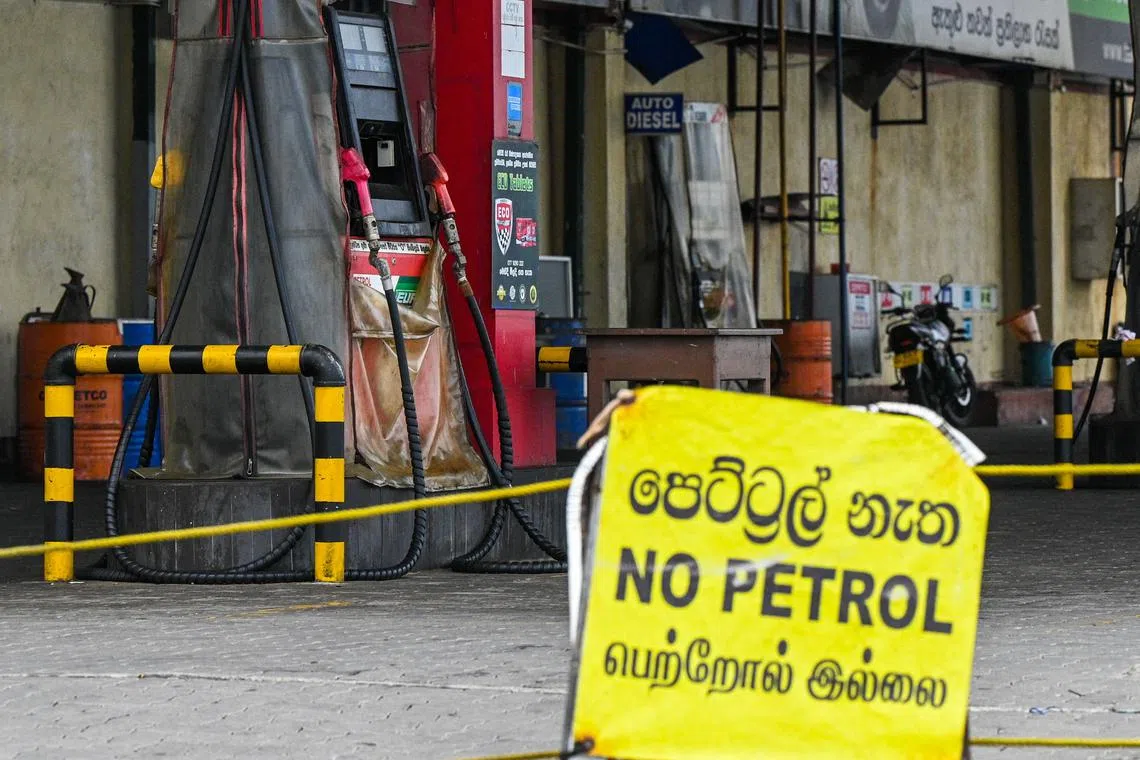Foreign debt relief is single biggest challenge: Sri Lanka foreign minister
Sign up now: Get ST's newsletters delivered to your inbox

The Sri Lankan government has raised fuel, electricity and water tariffs to prevent losses and borrowings to pay for imports.
PHOTO: AFP
Follow topic:
BENGALURU - Sri Lanka is working overtime on its diplomatic channels to convince its biggest bilateral lenders China, Japan and India to restructure their loans to the island, which is facing its worst ever economic crisis.
In an interview with The Straits Times on Monday, Foreign Minister Ali Sabry said “the single biggest challenge” before dollar-strapped Sri Lanka today was to win the assurances about debt relief from its bilateral lenders, which will help it secure a US$2.9 billion (S$4 billion) bailout
To get the bailout from the United States-based international lender of last resort, bankrupt Sri Lanka must “pass a checkpoint of demonstrating that its debt will be more sustainable in the future,” economist Anushka Wijesinha told ST. This involves getting provisional assurances from bilateral lenders like China, Japan and India and global private sector lenders about restructuring the terms of repayment. Only when Sri Lanka secures such assurances from its creditors will the IMF begin processing its bailout application.
Sri Lanka has a foreign debt of US$35 billion that includes bilateral, multilateral and commercial loans as at June 30. Most of it is owed to global private creditors through international sovereign bonds (debt instruments issued by the Sri Lanka government), which analysts say successive governments staked their import-dependent economy on for at least 15 years. It has to repay US$10.9 billion in bilateral loans, US$9.3 billion in multilateral borrowing, and US$14.8 billion for commercial loans, according to government data released on Nov 3.
China is the top bilateral lender, accounting for 43 per cent of the country’s total bilateral debt. Japan and India follow at 24 and 14 per cent respectively.
The highest levels of the Sri Lankan government are following up on the progress of debt restructuring “almost every other working day,” said Mr Sabry, who had a brief stint as finance minister this year. Sri Lanka wants its bilateral lenders to restructure its debt by reducing the principal amount or temporarily suspending interest payouts. Mr Sabry said Colombo had made some headway with Japan, which is being guided by the Paris Club of wealthy nations including France and Australia that have faced such demands before.
But convincing China and India is proving more difficult. Mr Wijesinha noted that “the major sticking point” was that China usually preferred to extend the maturity date of loans over “offering haircuts on debt”. But to maintain good relations with various countries, Sri Lanka would like to restructure all loans so that all creditors receive equitable treatment.
“China and India have both been part of the two important creditors’ meetings (with IMF teams and financial advisors to discuss debt restructuring). They’ve taken part enthusiastically, and we shared information they wanted. Hopefully we should be able to convince both those creditors as well as the others by the deadline,” said Mr Sabry.
If Sri Lanka misses the December deadline to give creditor assurances to the IMF, it will have to wait until March 2023 for the bailout, by which time its foreign reserves and currency could worsen, and the painful recession could deepen. Reeling under high debt and low dollar reserves due to the effects of the pandemic and ill-advised policies, it has not been able to repay foreign debts or import enough essentials like fuel, rice and lentils since last year. Food prices have spiked by 86 per cent in the interim, forcing many Sri Lankans to go hungry.
After suffering months of 13-hour power cuts and long lines for fuel, citizen protests erupted across the island returned to Sri Lanka in September
Protests dwindled in the island nation after the new Wickremesinghe government jailed prominent activists, and also reduced fuel shortages with purchasing assistance from India and a new voucher system to avoid long queues. The government has raised fuel, electricity and water tariffs to prevent losses and borrowings to pay for imports.
But for ordinary people, there is little relief.
“Life is as tough as it was some months ago,” said taxi driver Devaka Fernando, 32, who hasn’t seen tourists, his main source of income, since July.
Foreign minister Sabry urged “visitors who know our tourism potential” and investors who can take advantage of “our great location and human resources” to spend their dollars on Sri Lanka.
Ultimately, however, Sri Lanka’s problem is not the lack of economic ideas but their implementation, said Mr Wijesinha, co-founder of the think-tank Centre for a Smart Future. “Unfortunately, the cabinet, ministries and key institutions are headed by the same people whose decisions ruined the economy,” said Mr Wijesinha. In this dire scenario, he added, the IMF bailout could infuse some public hope and investor confidence and buy crucial time for the government to provide safety nets for the most vulnerable Sri Lankans.


